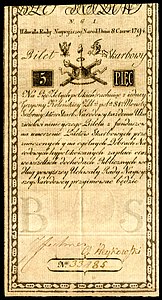| Revision as of 19:30, 11 September 2022 editRavenpuff (talk | contribs)Extended confirmed users, Page movers, Pending changes reviewers, Rollbackers66,176 edits copyedit← Previous edit | Revision as of 19:35, 11 September 2022 edit undoRavenpuff (talk | contribs)Extended confirmed users, Page movers, Pending changes reviewers, Rollbackers66,176 editsmNo edit summaryNext edit → | ||
| Line 1: | Line 1: | ||
| {{POTD {{{1|{{{style| |
{{POTD {{{1|{{{style|default}}}}}} | ||
| |image=POL-A2a-Bilet Skarbowy-10 Zlotych (1794 First Issue).jpg | |image=POL-A2a-Bilet Skarbowy-10 Zlotych (1794 First Issue).jpg | ||
| |size=1 | |size=1 | ||
Revision as of 19:35, 11 September 2022
Picture of the day archives: 2022 September < 2022 September 12 2022 September 14 > Picture of the dayThe Polish złoty is the official currency of Poland. While originally existing only as coinage, radical changes to the currency were made during the Kościuszko Uprising in 1794. The second partition of the vast Polish–Lithuanian Commonwealth resulted in the loss of approximately 200,000 square kilometres (77,000 sq mi) of land and precipitated an economic collapse. The widespread shortage of funds to finance the defense of remaining territories forced the insurrectionist government to look for alternatives. In June 1794, the Polish military leader Tadeusz Kościuszko began printing paper money as a substitute for coinage, which could not be minted in required quantities. The first Polish banknotes were issued on 8 July 1794. The banknotes depicted here, in five denominations from five to one hundred złotych, are from the first issue in 1794 and today form part of the National Numismatic Collection at the Smithsonian Institution.Banknote design credit: Kingdom of Poland; photographed by Andrew Shiva
Archive – More featured pictures...



